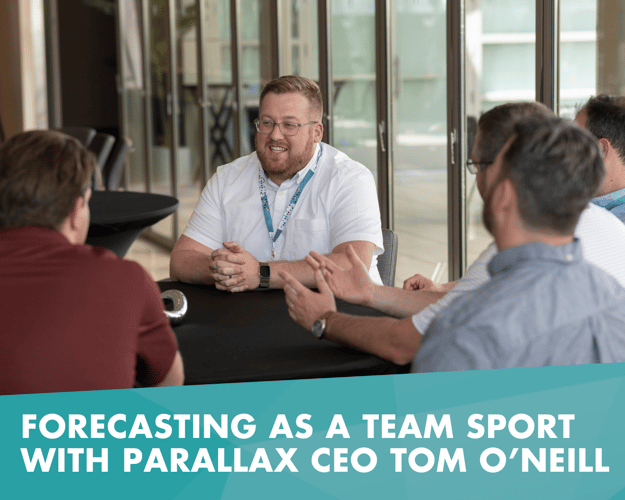Boom or bust, feast or famine. Growing agencies all experience the project-capacity rollercoaster – probably more often than they would like. As projects ramp up or down and team capacity grows or shrinks, tasks get triaged on a day-to-day or, if you’re in good shape, week-to-week basis. With so many variables, the thought of projecting capacity appears daunting. But how do you handle a flood of new work or scale back in a drought, without compromising profitability?
It’s a common problem, one that Tom O’Neill experienced first-hand while building a consulting firm over the course of 14 years, “from just a handful of nerds to over 500,” and about 85 million in annual sales, he discussed in a recent podcast interview.
His goal in founding Parallax – a resourcing or forecasting tool – was to build the tool he wishes he had had during his time as a CEO of a digital agency: “It always felt like we had too much work and not enough people or not enough work and too many people,” he says. “That roller coaster could flip on a weekly basis.”
After getting into the weeds with 40 different agencies and consultancies to find out how they handle this unparalleled challenge, Tom sees the secret to capacity forecasting. “You need to solve the problem from the right seat.”
While companies traditionally centralize forecasting and resourcing, having a single point of responsibility who needs to pull data from disparate systems, combine it, massage it, interview people about the current state of projects in the pipeline is very ad hoc, and not very repeatable.
Instead, Tom says, it’s best to take advantage of the expertise of people who are much closer to the business, whether they're project managers or team leads. What if, instead of having a ‘forecasting’ person interrogate them, they could be proactive?
To make that shift requires one major thing: The frontline team member needs that wider angle view of a CFO or a CEO who thinks about a project in the greater picture of the company. If you can teach a project manager to think like an operator, you’re that much closer to producing a forward-thinking forecast that provides actionable insights.
What is resource forecasting – and why does it matter?
If you’ve ever played Tetris, you might know a little something about the challenges of resource forecasting. A brick drops into your screen, and you’ve got just a few seconds to react – rotating and positioning it to join the other blocks that have already fallen, in the hopes of forming full lines with no empty holes. (More fun to play than to read about.)
The challenge with Tetris is that you have a really short runway. A piece appears and you have to position it without knowing which shapes are coming next.
Agency work can feel a lot like that. You get various “bricks” (projects), but with little insight into where they best fit, in terms of cash flow and resources. Triage-mode becomes second nature.
“It’s very common to see agencies that work on a day-to-day or week-to-week basis underperforming their expectations for growth, underperforming their expectations for margin, and underperforming their expectations for billable utilization.” This ripples across the whole agency, dragging down profitability.
“Yet, these agencies are also saying that their people feel like they’re working way harder than they need to. Then, in the next breath, that CEO or founder will say, ‘but I don't get it because they're only recording 38 hours on their timesheet.’ It's so common, but when you pull the onion back a few layers, you see that they're running the whole agency on this triage basis. It's so inefficient and so reactive.”
Most agencies know how much money is coming in. But saying there’s $500,000 in new projects in the CRM is fairly shapeless: It doesn’t tell the agency when they’re going to earn that revenue or what kind of people they need to get it done. That’s where a capacity forecasting tool comes in: starting at the project level, it forecasts the revenue, the margin and the people needed to do the work.
That information is invaluable to a CFO. When I sit down with a client who knows where they are in terms of which projects are hot and which are cold, I’ll be able to produce a way more accurate forecast. I can help a client who comes to me with real time info and says, “Jamie, we just lost this huge contract. I’m trying to replace it with these other three, but we aren’t quite getting there. What do we do?” We can pull levers before there are cash flow problems.
The #1 Rule of Resource Forecasting: Precision is the Enemy of Accuracy
Once you make the mindset shift and recognize the value of moving towards a forward-looking approach, you need to teach your team to roll up their sleeves and learn how to get it done. But how do you keep on top of who is doing what and how long it takes, especially when you’re providing customized services?
Get out of the weeds and estimate.
When people hear the word ‘forecast’ or ‘tracking,’ a common objection is that people don’t want to add more busy-work to their day. However, whether you’re recording time worked or forecasting how long your team plans to work, it’s not about getting every 10th of an hour perfect.
Ideally, agencies grow in the direction of generating around 80% of their revenue from productized services: services they can deliver consistently with a methodology and patterns.
That means that while there will be fluctuations in terms of how many people are working how many hours, it’s possible to project rough, lower fidelity estimates in terms of quarter-, half- or full-time per week.
A major benefit to this approach is that it allows us to define a methodology that we want our teams to employ and give them the training and materials to deliver. Once you take that kind of approach, you essentially eliminate the need for micromanaging, a habit that – Tom and I both agree – is one of the major enemies of growth.
Three things to look for in a resource forecasting tool
There are lots of forecasting tools available, but Tom recommends looking for these three attributes when deciding which to use. It allows you to forecast as a team. When frontline people are empowered to think like founders or more senior leaders, it allows for data that is accurate, timely and actionable.
-
It integrates with the new business team. Resource planning is more than just delivery. If all you’re trying to do is improve your production team’s utilization, you’re missing a major opportunity to consider the impact of projects that are coming down the pipeline but have not yet been signed. You want to be able to look at the shape of new, incoming opportunities, as soon as possible (remember: Tetris). If you can see your current backlog of work, layered on top of the potential pipeline, you can consider various best- and worst-case scenarios, and make decisions accordingly.
-
It plays nicely with others. Rather than replace your project management tool, your timesheet, your CRM, or your accounting function, look for a tool that integrates with them. If the goal is to see improvements in your variants between forecasts and actuals, a tool that integrates with your current tech stack will get you there faster.
From hero to coach
Agency owners know what to do when they have too much work. They know what to do when they don’t have enough work. But it feels like a roller coaster because they keep shifting their focus: “Oh my gosh, we have too much work to figure out how to get it done! Oh, no, we forgot to focus on new work.”
“They know the levers to pull,” says Tom, “they just pull them too late. So if the agency can learn to forecast as a team from the front line, the leaders can shift their focus to be more proactive and pull those levers when there’s still time.”
Forecasting as a team will change your business. It helps CEOs and founders shift their time and attention away from the hero mentality of thinking they can swoop in and fix things, towards the coach mentality of foreseeing a problem far enough in advance that they can get the team onboard and let them take their own initiative to resolve it.
The job of a CEO is not to just deal with the squeakiest wheel. You should know every problem and be able to choose which one you think needs addressing. If you're constantly putting out fires, and all you're doing is working on the hottest fire, you're not looking down the road. That’s what companies like Parallax and Summit aim to address. We give you the insight into the next step to make sure that you're making the right decisions and not just putting out fires.
As a CFO, I’ve seen the difference forecasting makes. Once an agency owner knows which “blocks” are coming down the pipeline, that frenetic vibe goes away. Instead, they can pull the right levers, before a fire even starts.
.png?width=120&height=77&name=Summit-Virtual-CFO_color_rgb%20(1).png)














